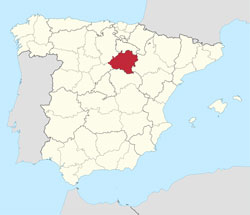Soria in Soria

Soria is a province in northern Spain, in the east of the autonomous region of Castilla y León. It borders on two fellow Castilla y León provinces: Burgos and Segovia, as well as the autonomous regions of La Rioja, Aragón and Castilla La Mancha. The province is, by far, the least populated in Spain with its 8.6 inhabitants/km2 – one of the lowest population densities in the EU.
There are 88,636 inhabitants, 44.44% of whom (39,398) live in the capital of the same name. Moreover, it has one of Europe’s most elderly populations: 6% of the inhabitants are over 85 years old. There are over 500 hamlets distributed over 183 municipalities, 116 of which have less than 100 inhabitants. Only 11 have more than 1,000 inhabitants, and only the cities of Almazán and Soria, the capital, have more than 5,000 inhabitants.
 The average height of Soria is 1025 MASL, and that, together with the mountain ranges in the north of the province, conditions short, hot summers and long, very cold winters. There are several natural parks in Soria, the most famous of which is possibly Parque Natural Laguna Negra, birthplace of the river Duero and setting of numerous legends around the Black Lagune itself. The highest point of the province is Moncayo at 2,314.3 MASL, which Soria shares with Zaragoza in Aragon.
The average height of Soria is 1025 MASL, and that, together with the mountain ranges in the north of the province, conditions short, hot summers and long, very cold winters. There are several natural parks in Soria, the most famous of which is possibly Parque Natural Laguna Negra, birthplace of the river Duero and setting of numerous legends around the Black Lagune itself. The highest point of the province is Moncayo at 2,314.3 MASL, which Soria shares with Zaragoza in Aragon.
The capital of Soria, Soria, is Spain’s second highest provincial capital at 1063 MASL. Only Ávila, also in Castilla y León, is higher. The city is situated on the banks of the river Duero. As mentioned above, there are 39,398 inhabitants in Soria, which makes it Castilla y León’s least populated capital and the second least populated of Spain. Only Teruel in Aragon houses fewer souls.
The first signs of human presence in the area date back 2-3,000 years to the Bronze Age when nomadic groups made rock paintings, which are now some of the most important finds of their kind in all of Spain. In the Cerro de La Muela hills, rests of an old settlement have been found which dates back to the Iron Age and Celtiberian populations; it is thought to be the last Celtic city, Numantia, which went down in history as home to one of the fiercest anti-Roman populations of all times. Its resistance against the Roman invaders from the year 200 BC was relentless, and only after over 20 years of wars and a long siege did the Romans manage to conquer the city.
Most of the inhabitants, however, preferred death to Roman rule and committed suicide rather than bow to the victors. The Romans populated the city with people from surrounding Celtiberian tribes, but Numantia’s days were counted, and it is thought that it had ceased to exist by the 3rd century AD.
Soria’s period of glory was the second part of the Middle Ages; its commerce was made to flourish by the more than 1,200 Jews that lived in the area. At that time, a lot of the commerce revolved around the wool trade. Soria, as capital of a province where many of the cattle tracks started, was where sheep were sheared in summer and they sent the precious fleece to Burgos and the ports in the north of the Peninsula.
In the present day, Soria, although a small capital, is a bustling city, not least thanks to the increasing number of tourists that visit, attracted by its medieval and historic charms; a little step back in time. However, the very charm of yesteryear is also the city’s bane, and the scarce communications and insufficient infrastructure combine to obstruct the city’s growth and development.


